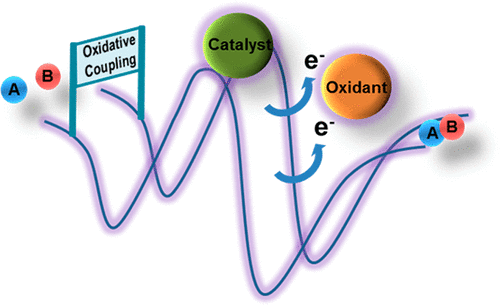当前位置:
X-MOL 学术
›
ACS Catal.
›
论文详情
Our official English website, www.x-mol.net, welcomes your
feedback! (Note: you will need to create a separate account there.)
Oxidative Coupling Mechanisms: Current State of Understanding
ACS Catalysis ( IF 11.3 ) Pub Date : 2018-01-19 00:00:00 , DOI: 10.1021/acscatal.7b02974 Ignacio Funes-Ardoiz 1 , Feliu Maseras 1, 2
ACS Catalysis ( IF 11.3 ) Pub Date : 2018-01-19 00:00:00 , DOI: 10.1021/acscatal.7b02974 Ignacio Funes-Ardoiz 1 , Feliu Maseras 1, 2
Affiliation

|
Oxidative coupling reactions, where two electrons are released from the reactants and trapped by an oxidant, have arisen as a versatile alternative to cross-coupling in chemical synthesis. Despite the large number of experimental reports on the process, a clear mechanistic picture is only starting to emerge. In this perspective, we highlight the contribution from density functional theory (DFT) calculations to the computational characterization of this mechanism. Oxidative coupling processes have been reported, differing in both the catalyst (radicals, precious metals, or Earth-abundant metals) and the oxidant. We have found it more useful to classify them according to the oxidant used, as metal-based oxidants and metal-free oxidants seem to favor different mechanistic variations. All steps in the full catalytic cycle are analyzed, and issues concerning selectivity and influence of the oxidant are considered.
中文翻译:

氧化偶联机理:目前的理解状态
氧化偶联反应是化学合成中交叉偶联的一种通用替代方法,其中两个电子从反应物中释放出来并被氧化剂捕获。尽管有大量关于该过程的实验报告,但是清晰的机械图才刚刚开始出现。从这个角度来看,我们强调了密度泛函理论(DFT)计算对该机制的计算特性的贡献。已经报道了氧化偶联过程,其在催化剂(自由基,贵金属或富含地球的金属)和氧化剂方面都不同。我们发现根据使用的氧化剂对它们进行分类更为有用,因为基于金属的氧化剂和不含金属的氧化剂似乎倾向于不同的机械变化。分析整个催化循环中的所有步骤,
更新日期:2018-01-19
中文翻译:

氧化偶联机理:目前的理解状态
氧化偶联反应是化学合成中交叉偶联的一种通用替代方法,其中两个电子从反应物中释放出来并被氧化剂捕获。尽管有大量关于该过程的实验报告,但是清晰的机械图才刚刚开始出现。从这个角度来看,我们强调了密度泛函理论(DFT)计算对该机制的计算特性的贡献。已经报道了氧化偶联过程,其在催化剂(自由基,贵金属或富含地球的金属)和氧化剂方面都不同。我们发现根据使用的氧化剂对它们进行分类更为有用,因为基于金属的氧化剂和不含金属的氧化剂似乎倾向于不同的机械变化。分析整个催化循环中的所有步骤,











































 京公网安备 11010802027423号
京公网安备 11010802027423号